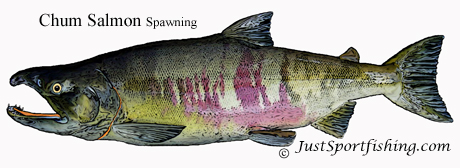|
Home Game Fish Fishing Knots Tackle Tips Videos Pictures Tips Rods & Reels Boats Cook your Catch Articles About Contact |
|
Donate to JustSportfishing.com and help to build the largest fishing information site on the web. Even a dollar or two will keep us building this free site. |
Chum
Salmon World
Record
~ 35 Lbs Caught at Edye Pass, British Columbia
on July 11, 1995 by angler Todd Johansson. Scientific
name
~ Oncorhynchus Keta Other
names
~ Dog Salmon, fall Salmon, chum, Calico salmon Identification
~ Chum Salmon are the second
largest of the Salmon species. When the Chum Salmon is in the ocean they
are chrome and sleek. While chum are void of stripes in saltwater, the
strips can be seen by tilting the landed fish one way or another; the
stripes further distinguish it from other species of salmon. As they
mature and get closer to their spawning streams they develop a dark
olive back, purple and gray tiger stripes are found along the lateral
areas, which differentiate them along with the kype (jaw hook) of the
male distended with large canine-like teeth. Size
~ The angler caught Chum Salmon usually ranges from 10 to 15 pounds but
catches of Chum salmon over 20 pounds are not that uncommon. The females
tend to be smaller than the males. Chum salmon can live to 7 years but
usually spawn after 4 years. Habitat
~ Chum salmon spawn in the lowermost reaches of rivers and streams,
typically within 62 miles (100 km) of the ocean. Spawning sites are
often near springs. They migrate almost immediately after hatching to
estuarine and ocean waters, in contrast to other Pacific salmonids,
which migrate to sea after months or even years in fresh water. This
means that survival and growth in juvenile chum salmon depend less on
freshwater conditions than on favorable estuarine and marine conditions.
The species has the widest natural geographic and spawning distribution
of any Pacific salmonid, primarily because its range extends farther
along the shores of the Arctic Ocean than that of the other salmonids.
Spawning populations are known from Korea and Japan and into the far
north of Russia. Historically, in North America, chum salmon were
distributed throughout the coastal regions of western Canada and the
United States, as far south as Monterey, California. Presently, major
spawning populations are found only as far south as Tillamook Bay on the
northern Oregon coast. Feeding
Habits
~ Chum salmon feed on insects and marine invertebrates while in rivers.
As adults, their diet consists of copepods (tiny crustaceans), small
fish such as herring, mollusks, squid and tunicates (sea worms).
|


